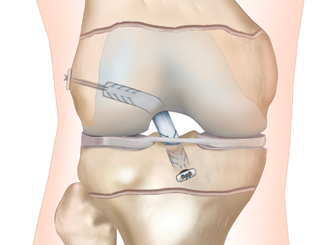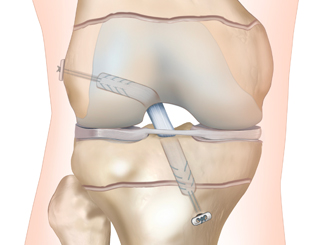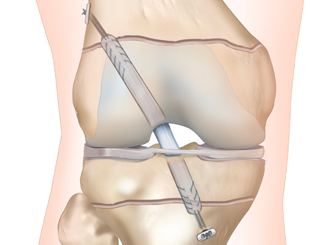Pediatric ACL Reconstruction
ACL Reconstruction: Graft Selection
ACL reconstruction involves the replacement of the ruptured (torn) ligament with a tendon graft. Graft tissue is either taken from the patient (autograft) or from a tissue donor (allograft).
The source of the graft tissue and the technique depend on the severity of the injury, age and activity level of the patient, desired outcome, and knee surgeon Dr. Chahla’s preferred method. In pediatric cases, studies have found autografts to be superior to allografts in overall surgical outcome and return to sport. Therefore, for pediatric ACL reconstructions, Dr. Chahla recommends use of an autograft. Each type of autograft has its advantages and disadvantages, and it is important that you discuss any questions you may have with Dr. Chahla during your appointment as you choose from the graft options below.

ACL Reconstruction Pediatric Technique:
During your child’s consultation with ACL surgeon Dr. Chahla, x-rays will be obtained. X-rays are a critical part of the pre-operative evaluation, as the images allow Dr. Chahla to evaluate your child’s growth plates (physes). The growth plates are areas of developing cartilage at the ends of long bones, and they are crucial for the proper growth and development of bones in children and adolescents. Children and adolescents have open growth plates at the ends of their bones. As children and adolescents grow, the growth plates close. At this stage a hand xray can allow us to determine how much growth is remaining.

In traditional ACL reconstruction, the tunnels created for the new ACL graft include the physes of the bone. This is not a problem for patients with closed physes. However, for growing children and adolescents with open physes on x-ray, knee surgeon Dr. Chahla will recommend a physeal-sparing ACL reconstruction technique to preserve the growth plates and avoid unnecessary complications such as growth disturbances and limb length discrepancies.
Physeal-sparing ACL reconstruction is a surgical technique specifically designed for pediatric patients, taking into consideration the presence of open physes in their bones. Physeal-sparing techniques are used to minimize the impact on the growth plates. Using this technique, knee surgeon Dr. Chahla can successfully reconstruct the ACL while preserving the integrity of the growth plates and avoiding interference with the natural growth and development of the bones. This is achieved through careful surgical planning and tunnel positioning designed around the unique anatomy of growing bones.


The primary goal of this technique is to provide a safe and effective solution for ACL injuries in pediatric patients without compromising their future growth. By performing physeal-sparing ACL reconstruction, knee surgeon Dr. Chahla is prioritizing the long-term health and functionality of the joint and minimizing the risk of complications related to growth plate damage, while still allowing your child to return to their normal activities after recovery from surgery. If growth plates are almost closed and height is similar to that of their parents, an adult technique can be performed.

When an ACL tear requires surgical intervention, pediatric ACL reconstruction may be the best solution to restore stability and allow young athletes to return to sports safely. Dr. Jorge Chahla uses advanced techniques to reconstruct the ACL while preserving the child’s natural knee anatomy and growth potential. If your child has suffered an ACL injury and requires reconstruction, contact board-certified knee surgeon, Dr. Chahla, at his Chicago, Naperville, or Oak Brook locations to learn about the latest surgical techniques and recovery protocols.
- Triple fellowship-trained sports medicine surgeon
- Performs over 800 surgeries per year
- Associate professor of orthopedic surgery at Rush University
- Learn more
